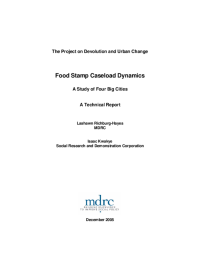Food Stamp Caseload Dynamics
A Study in Four Big Cities: A Technical Report
The passage of the Personal Responsibility and Work Opportunity Reconciliation Act (PRWORA) in 1996 placed a federal time limit on the receipt of cash assistance and encouraged states to move welfare recipients off the rolls and into work, which was expected to place pressure on the federal Food Stamp Program (FSP) — a system designed to prevent hunger among the nation’s low-income population. In addition, PRWORA limited the extent to which able-bodied adults without dependent children (hereafter, adults without children) and immigrants could receive food stamps (some states, including California and Florida, used state funds to mitigate the impact of these changes, however). How did food stamp participation change during this period of new restrictions on both cash assistance and food stamp benefits? This report describes the dynamics of participation in the FSP: how quickly people enter and leave the program, how likely they are to return to it, and how the outcomes for those measures vary for different groups. The report analyzes data from January 1993 through December 2001 in four large, urban counties that are part of MDRC’s Project on Devolution and Urban Change: Cuyahoga County, Ohio; Los Angeles, California; Miami-Dade County, Florida; and Philadelphia, Pennsylvania.
- In all four counties, food stamp caseloads declined over time. Over the entire period from 1993 to 2001, overall food stamp caseloads decreased by 51 percent in Cuyahoga, 44 percent in Philadelphia, 22 percent in Los Angeles, and 18 percent in Miami-Dade. The decline occurred because the number of people leaving from 1994 onward was slighter greater than the number entering.
- Rates of exit from the FSP varied widely among different populations. Across the counties studied, adults without children were the most likely and the elderly were the least likely in each county to leave the FSP within any given time period.
- The majority of FSP spells lasted for 7 months or more. The median spell lengths of food stamp receipt were 11 months in both Cuyahoga and Philadelphia, 9 months in Miami-Dade, and 7 months in Los Angeles. Adults without children had shorter average spells than other household types, while the elderly had the longest spell lengths.
- In most counties, the proportion of entrants who returned to the FSP after being off the rolls (that is, the recidivism rate) initially declined but eventually returned to pre-reform levels. In March 1993, the percentage of people returning to the FSP within six months ranged from 26 percent in Philadelphia to 38 percent in Los Angeles. By September 1996, the percentage of individuals returning declined in Los Angeles, Miami-Dade, and Philadelphia but, by 2001, rose back up to 1993 levels in Miami-Dade and Los Angeles. In contrast, in Cuyahoga, the percentage of people returning to the FSP ranged from 28 percent in the beginning of 1993 to as high as 37 percent by 1998. However, the recidivism rate there declined back to 1993 levels by the end of 2001.
Overall, the study’s findings indicate that people in these four urban counties were leaving the FSP faster than others were entering. Future analyses should look at food stamp leavers, in addition to examining the factors that lead to FSP entry and exit.






